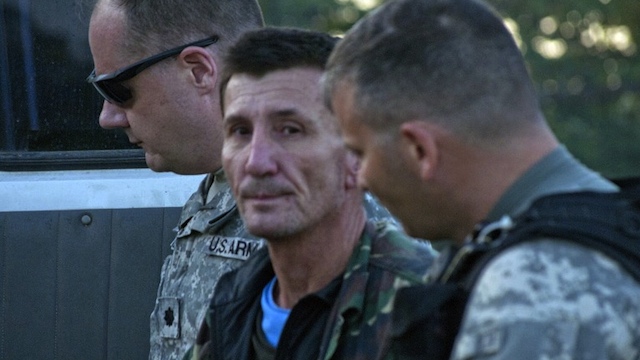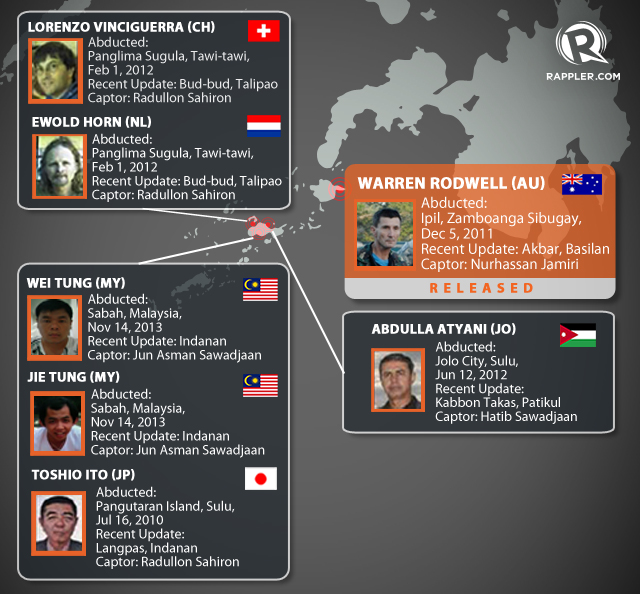SUMMARY
This is AI generated summarization, which may have errors. For context, always refer to the full article.

When ABC Australia asked me if ransom had been paid for the release of Australian Warren Rodwell, there was only one answer: yes. Despite the denials of the Australian and Philippine governments, money changed hands or else he wouldn’t have been freed by a group that has turned kidnap-for-ransom into a cottage industry.
The ransom demand went as high as US$2 million, and when negotiations hit a snag, the kidnappers turned to technology. For the first time, proof-of-life video messages and photos were posted on YouTube and Facebook, the kidnappers’ clumsy attempt at crowdsourcing his ransom. The kidnappers’ threat to kill him was also posted on Facebook. Interestingly, a small group of Australians also turned to Facebook to keep Rodwell’s plight in the public eye.
A little more than 15 months after Rodwell was kidnapped, military and police intelligence sources told Rappler the Abu Sayyaf and other armed men who held him hostage agreed to release him for P5 million or about US$125,000 on Thursday, March 21. However, his release was delayed until early Saturday morning because, the same sources said, most of the money expected by the kidnappers never reached them, apparently taken by conduits and middlemen.
After initially denying ransom was paid, Basilan Vice Governor Al Rasheed Sakalahul said he saw P4 million or about US$100,000 counted in front of Abu Sayyaf leader Puruji Indama and Roger Gutang, the brother of Rodwell’s wife. Sources say a total of P7 million was paid with only P4 million reaching the kidnappers.

Looking tired and emaciated, Rodwell is free, but as one intelligence official told me, “there’s a United Nations” left behind in Jolo, Sulu.
A classified intelligence document obtained by Rappler from a western nation showed that as of January 18 this year, the Abu Sayyaf held 11 hostages, 10 of them in Jolo. The 11th, Rodwell, was in Basilan.
By the time of Rodwell’s release a little more than 2 months later, there are 6 foreign hostages left – a Japanese, Swiss, Dutch, Jordanian and two Malaysians.
Left behind
Japanese Toshio Ito was kidnapped nearly 3 years ago from Pangutaran Island in Sulu on July 16, 2010. At one point, the Philippine police believed the 64 year old “treasure hunter,” a Muslim convert, had joined the Abu Sayyaf – a form of Stockholm Syndrome which had him acting as the group’s cook. However, this was disputed by other nations, including the United States, which includes him on its list of kidnap victims. The classified document obtained by Rappler lists Ito first and says he was held captive by Abu Sayyaf’s most senior leader, Radullan Sahiron, in Langpas, Indanan, Sulu early this year. Little happens among Jolo’s armed groups without Sahiron’s approval.
54 year old Warren Rodwell is second. Here’s a timeline of key events from the time he was kidnapped on December 5, 2011 until his release on Saturday, March 22, 2013. Rodwell’s kidnappers were turned away from Jolo by Sahiron, a member of the Abu Sayyaf told me. Puruji Indama, who allegedly received the ransom, works with Nurhassan Jamiri for the overall leader of the Abu Sayyaf in Basilan, Khair Mundus.

At numbers 3 and 4 are well-known European birdwatchers: 53 year old Dutch Ewold Horn and 48 year old Lorenzo Vinciguerra. They were bird-watching for 4 days on Tawi-Tawi when they were kidnapped by armed men on February 1, 2012. They were ultimately brought to the Abu Sayyaf in Jolo, Sulu. That same classified document says they were held captive by Radullan Sahiron in Bud-Bud, Talipao in Jolo.
Number 5 is Jordanian “Abdulla Atyani” – better known as Baker Atyani, a well-known journalist with Al-Arabiya who interviewed Osama bin Laden. He was kidnapped on June 12, 2012, along with two Filipino crew members. Intelligence officials said they were initially unsure whether he was a kidnap victim because they believed he was holding lectures for senior Abu Sayyaf leaders.
A classified Philippine intelligence document obtained by Rappler states Atyani coordinated not just with the Abu Sayyaf but also with Malaysian Jemaah Islamiyah member Amin Bacho (known as Abu Jihad). Over time, however, a relatively “public” fight between Amin Bacho and Radullan Sahiron over Atyani’s captivity pushed Bacho to leave Sahiron’s group.
The classified Western intelligence document states that as of early this year, Atyani and his crew were held captive by one of Sahiron’s sub-commanders, Hatib Sawadjaan, in Kabbon Takas, Patikul in Jolo, Sulu.
His two Filipino crewmembers, Ramilito Vela and Rolando Letrero, were freed on February 2 this year after 7 months and 20 days in captivity. This was after sustained pressure by MNLF leader Habier Malik, who went to Jolo to push for Atyani’s release. A few days after the Filipinos’ release, Malik attacked the Abu Sayyaf camps but Atyani and his captors escaped.
Finally, there are 2 Malaysians, Wai Tung and Jie Tung, listed on the Jan. 18 intelligence document. Rappler cross-verified with a classified Philippine report, which lists them as 35 year old Tung Wee Wei and 25 year old Tung Wee Jie. They were kidnapped on November 14, 2012 by 3 armed men from Lahad Datu, Sabah. They used a twin-engine, green speed boat to take them to Sitangkai island in Tawi-Tawi before bringing them to Jolo and handing them over to another Sahiron subcommander, Jul Asman Sawadjaan in Indanan, Sulu.
Cottage industry
The Abu Sayyaf has turned kidnapping-for-ransom into a cottage industry. Handing hostages to larger, better armed groups is a common practice. Larger groups can better protect and evade authorities. All involved then get a cut of the ransom, according to members of Abu Sayyaf.
There have been 4 waves in the Abu Sayyaf’s evolution, alternating between terrorism and crime.
It was formed and funded in the early 90’s by a splinter group from the Moro National Liberation Front (MNLF), then the largest Muslim separatist group in the Philippines, aided by the brother-in-law of Osama bin Laden and trained by agents of al-Qaeda. This period ran from 1991 to 1998.
The second wave happened after the death of its ideological founder, Abdurajak Janjalani and ran from 1998 till 2002. A spate of kidnappings bringing in millions of dollars in ransom happened during this time period: in March 2000, the Abu Sayyaf kidnapped more than 50 teachers and students from Basilan, followed a little more than a month later by the kidnapping of 21 people from 7 countries from a Malaysian diving resort on the island of Sipadan. The international tourists were later released for ransom, according to the chief negotiator then, who said about US$10 million to $15 million changed hands.
The third wave of the Abu Sayyaf’s development began after the Bali bombings on October 12, 2002. Some leaders from Jemaah Islamiyah, then functioning as al-Qaeda’s arm in Southeast Asia, fled to the Philippines for sanctuary, helping reorient the Abu Sayyaf towards terrorism again in its third wave of evolution between 2002 to 2008.
During that time, the Abu Sayyaf carried out the region’s worst maritime terrorist attack, the Superferry bombing in 2004. A year later, it carried out near-simultaneous, coordinated attacks, including one in Manila, on Valentine’s day.
Finally, the fourth wave began in 2008 with the kidnapping of an ABS-CBN news team, signaling the degeneration of the Abu Sayyaf back into kidnapping for ransom. That was followed 6 months later by the kidnapping of members of the International Committee of the Red Cross.
The January 18 classified document obtained by Rappler ends with this assessment: “Abu Sayyaf members on Sulu and Zamboanga have recently demonstrated a willingness and ability to coordinate target surveillance for potential kidnapping operations. Cooperation between KFR [kidnap-for-ransom] groups expand potential holding areas and increases the support network available to the kidnappers. Funds received through KFR’s, extortion and other criminal acts enable the Abu Sayyaf to purchase components needed to create IEDs [improvised explosive devices] to support extortion operations as well as acquire weapons and transportation necessary for future kidnapping attempts.”
The cycle continues. – Rappler.com
Maria A. Ressa is the author of FROM BIN LADEN TO FACEBOOK launched in the Philippines on the 10th anniversary of the Bali bombings. International & digital editions launch in Singapore April 2. She led the crisis team which negotiated the release of the ABS-CBN news team kidnapped by the Abu Sayyaf in 2008.
Add a comment
How does this make you feel?
There are no comments yet. Add your comment to start the conversation.